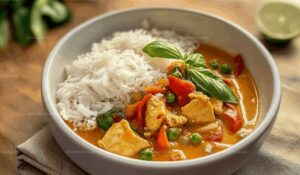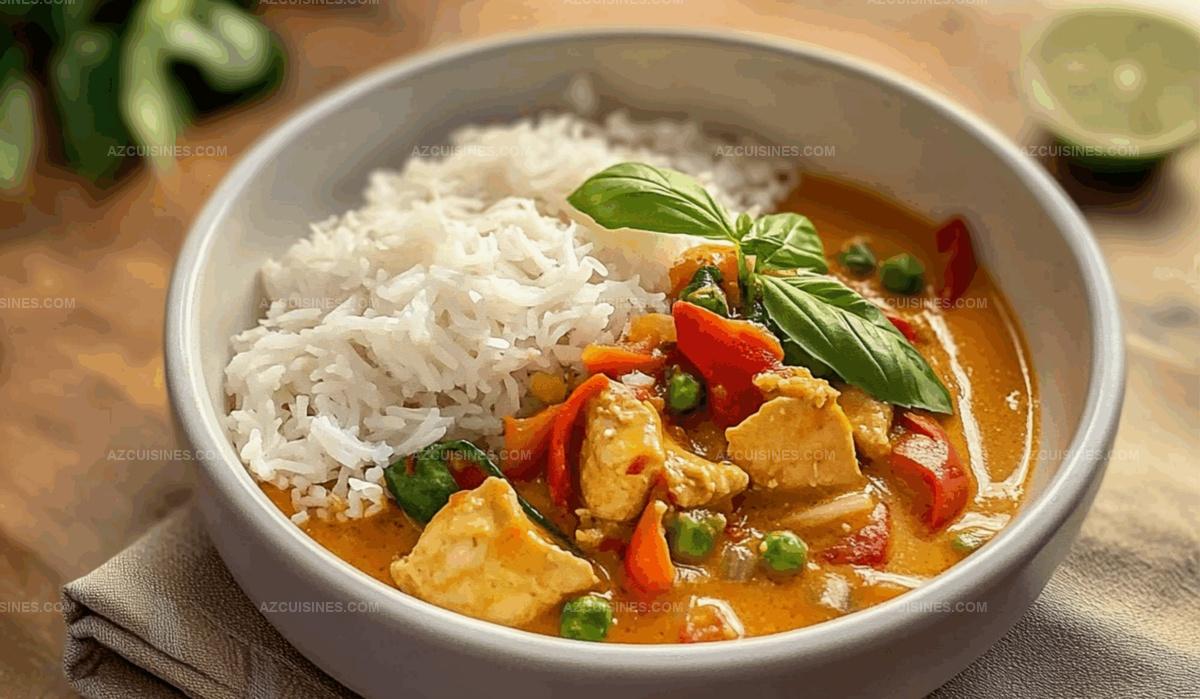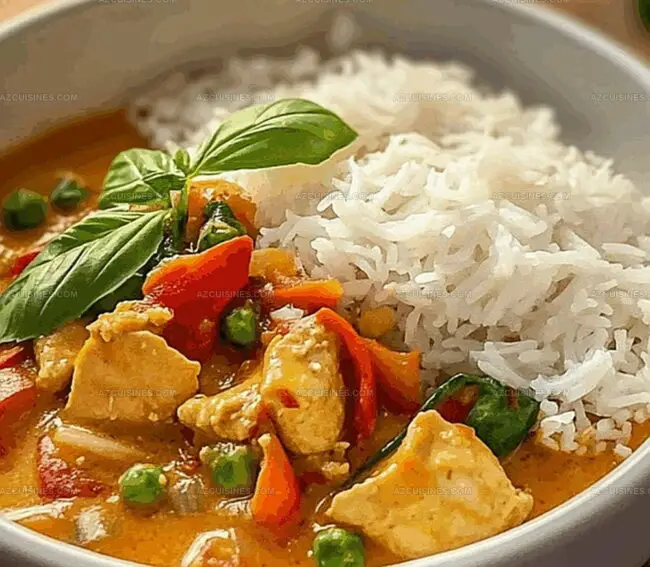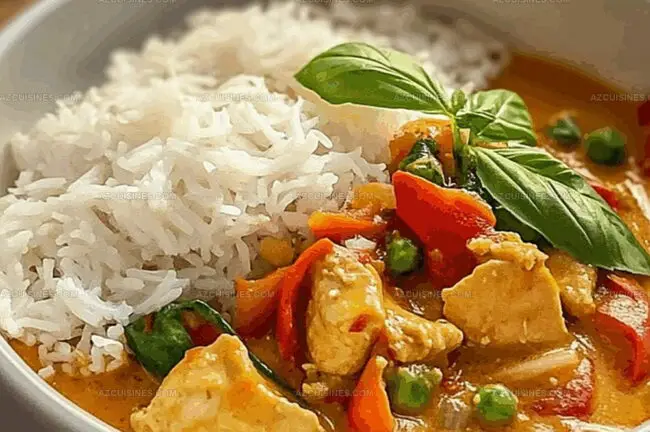The Best Panang Curry Recipe: Homemade Thai Magic in Minutes
Crafting a mouthwatering panang curry at home brings exotic Thai flavors right to your kitchen.
Fragrant spices dance together, creating a symphony of taste that transports you to bustling street markets.
Coconut milk adds a creamy richness that blankets tender protein with velvety smoothness.
Bright herbs and complex seasonings weave magic into every single bite.
Fresh ingredients become your secret weapon for an authentic culinary adventure.
This recipe promises a delectable journey through traditional thai cuisine that will surprise and delight.
You can master these bold, complex flavors with just a few simple techniques.
Why You’ll Love Cooking Panang Curry At Home
Ingredients For Panang Curry Made Simple
Proteins:Aromatics and Vegetables:Sauce and Seasoning:Step-By-Step Guide To Panang Curry
Step 1: Sizzle Protein in Hot Pan
Heat vegetable oil in a large skillet or wok over medium-high heat. Add and sear chicken and shrimp until they turn golden and are almost fully cooked, creating a beautiful caramelized exterior.
Step 2: Awaken Curry Flavors
Stir panang curry paste into the skillet, ensuring the proteins are completely coated and the spices release their vibrant aroma.
Step 3: Create Creamy Curry Base
Pour coconut milk into the pan, transforming the mixture into a luxurious, velvety sauce that will embrace all the ingredients.
Step 4: Balance Flavor Profile
Introduce fish sauce and palm sugar to the skillet, harmonizing the taste with a perfect blend of salty and sweet notes.
Step 5: Add Colorful Vegetables
Mix in:Allow these ingredients to simmer and soak up the rich curry sauce, creating depth and texture.
Step 6: Infuse Citrus Essence
Gently fold kaffir lime leaves into the curry, releasing a subtle, bright citrus fragrance that elevates the entire dish.
Step 7: Develop Rich Sauce
Reduce heat to low, letting the curry gently simmer. This process thickens the sauce and allows flavors to meld together beautifully.
Step 8: Finish with Fresh Herbs
Remove from heat and sprinkle fresh Thai basil leaves, stirring to release their aromatic oils and add a final layer of complexity.
Step 9: Brighten with Citrus
Add a splash of lime juice to lift and illuminate the overall flavor profile of the curry.
Step 10: Plate and Garnish
Serve the panang curry over steamed jasmine rice. Top with:These garnishes provide delightful texture and a fresh finish to the dish.
Helpful Tips For Creamy Panang Curry
Tasty Twists On Panang Curry To Try
Best Pairings For Panang Curry
Storing Panang Curry The Easy Way
Common Questions On Panang Curry
Panang curry paste typically contains red chilies, garlic, shallots, lemongrass, galangal, kaffir lime zest, cumin seeds, coriander seeds, and sometimes peanuts, creating a complex and aromatic spice blend.
Panang curry is generally milder and creamier compared to other Thai curries, with a subtle heat that’s balanced by coconut milk, making it more accessible for those who prefer less spicy dishes.
Yes, you can replace kaffir lime leaves with lime zest, use regular basil instead of Thai basil, and swap shrimp with tofu or additional chicken if needed, while maintaining the core flavor profile.
Print
Panang Curry Recipe
- Total Time: 25 minutes
- Yield: 4 1x
Description
Panang curry brings Thai culinary magic to your kitchen, blending creamy coconut richness with spicy-sweet flavor profiles. Delightful coconut milk and tender proteins create a comforting meal you’ll crave again and again.
Ingredients
Proteins:
- 1 lb chicken breast, sliced
- 0.5 lb shrimp, peeled and deveined
Curry Base:
- 2 tbsp panang curry paste
- 1 can (14 oz / 400 ml) coconut milk
- 2 tbsp fish sauce
- 1 tbsp palm sugar
Vegetables and Herbs:
- 1 red bell pepper, sliced
- 0.5 cup bamboo shoots
- 0.25 cup Thai basil leaves
- 2 kaffir lime leaves
- 1 tbsp lime juice
Garnish and Extras:
- 2 tbsp chopped peanuts
- 2 cups cooked jasmine rice
- 1 green onion, sliced
Cooking Oil:
- 2 tbsp vegetable oil
Instructions
- Heat vegetable oil in a large skillet or wok over medium-high heat until shimmering.
- Add sliced chicken and shrimp, searing until the proteins turn golden and are almost fully cooked, approximately 3-4 minutes.
- Incorporate panang curry paste into the skillet, stirring vigorously to coat the proteins and release the aromatic spices.
- Pour coconut milk into the pan, creating a creamy base that will envelop the proteins and vegetables.
- Stir in fish sauce and palm sugar, balancing the flavors with a harmonious blend of salty and sweet elements.
- Add sliced red bell pepper and bamboo shoots, allowing them to simmer and absorb the rich curry sauce for 2-3 minutes.
- Gently fold in kaffir lime leaves, introducing a subtle citrusy fragrance to the curry.
- Reduce heat to low and let the curry gently simmer, thickening the sauce and melding the flavors together for an additional 5 minutes.
- Remove from heat and sprinkle fresh Thai basil leaves, stirring to release their aromatic oils.
- Finish with a splash of lime juice to brighten the overall taste profile.
- Serve the panang curry over steamed jasmine rice, garnishing with chopped peanuts and sliced green onions for added texture and freshness.
Notes
- Adapt the heat level by adjusting the amount of panang curry paste, catering to individual spice tolerances.
- Swap proteins easily by replacing chicken and shrimp with tofu, beef, or mixed vegetables for vegetarian and alternative diet options.
- Toast peanuts briefly before chopping to enhance their nutty flavor and provide a more intense crunchy garnish.
- Use fresh ingredients like homemade curry paste or recently purchased kaffir lime leaves to maximize authentic Thai flavor complexity.
- Prep Time: 10 minutes
- Cook Time: 15 minutes
- Category: Dinner, Lunch
- Method: Sautéing
- Cuisine: Thai
Nutrition
- Serving Size: 4
- Calories: 700
- Sugar: 5 g
- Sodium: 900 mg
- Fat: 35 g
- Saturated Fat: 15 g
- Unsaturated Fat: 20 g
- Trans Fat: 0 g
- Carbohydrates: 80 g
- Fiber: 3 g
- Protein: 40 g
- Cholesterol: 150 mg




Truc Tran (Kris)
Senior Food Editor
Expertise
Home Cooking, Meal Planning, Recipe Development, Baking and Pastry, Food Editor, Cooking-video Maker, Vietnamese Food Evaluation Expert
Education
Truc Tran (Kris), an experienced food writer and editor, is great at exploring and describing global cuisines, from simple street food to fancy dining. In her writing, she skillfully mixes different flavors, cooking methods, and culinary traditions, showing the unique character of various cultures through their food and drinks. On azcuisines.com, Kris highlights her knowledge, especially in Asian cuisine and worldwide traditional dishes.